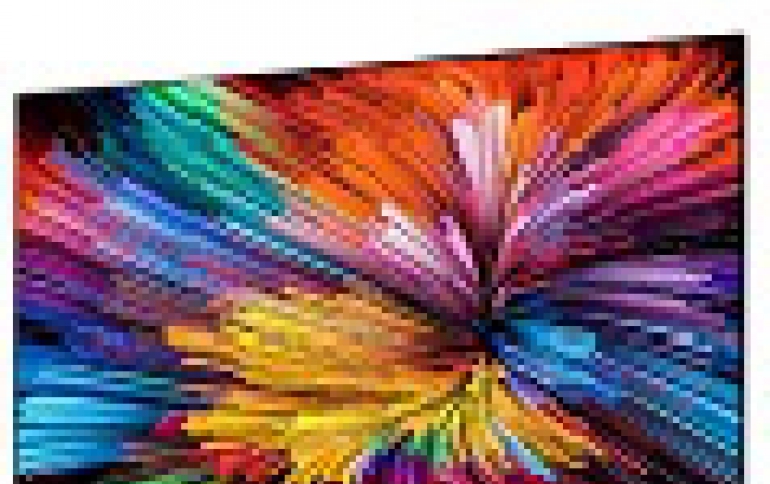
LG Unveils Its 2017 Super UHD TV Lineup Featuring Nano Cell Technology
LG's 2017 UHDTV lineup is not only about OLED. The company's LCD TV lineup is featuring 'Nano Cell technology' and deliver color from Technicolor, active HDR with Dolby Vision and a minimalistic design.
The third generation LG SUPER UHD TV lineup (models SJ9500, SJ8500 and SJ8000) is featuring Nano Cell LCD displays, which are employing uniformly-sized particles approximately one nanometer in diameter to create more subtle, accurate colors that can be viewed from wider angles than other TVs.
According to LG, the new TVs deliver consistent colors at wider viewing angles with virtually no color difference for viewers seated directly in front of the screen and those watching from a 60 degree angle.

Nano Cell achieves such results by absorbing surplus light wavelengths, enhancing the purity of the colors displayed on the screen. These light absorbing capabilities allow LG's new LCD displays to filter distinct colors with much greater precision. For example, the color green on conventional TVs can blend with other color wavelengths - such as yellow or blue - causing the color to fade and take on yellowish or cyan hues. LG Nano Cell reduces instances of color fading, image instability and other color degradation issues. Nano Cell technology also reduces on-screen light glow to maintain high picture quality even when the screen is surrounded by intense ambient lighting.

To build on the color technologies of LG's SUPER UHD TVs, LG has partnered with Technicolor, Hollywood's expert in image and color, to offer TV image quality that accurately recreates the artistic intent of content creators. This partnership enhances the color reproduction technologies of LG's 4K TVs.
Furthermore, LG's new Nano Cell TVs use improved ULTRA Luminance technology to deliver brighter, crisper image highlights. With support for BT.2020 and the ability to render over one billion possible colors, every new LG SUPER UHD TV is equipped with Active HDR and Dolby Vision, allowing for display of next generation HDR content that has been designed to render brighter scenes and greater shadow detail. Active HDR allows the TV to process the HDR picture frame-by-frame and inserts dynamic data where needed. This process allows the TV to offer the best picture to the viewers, whether the original HDR content contains dynamic, static or no metadata at all.
The new lineup also supports a variety of HDR technology, including Dolby Vision, HDR10, Hybrid Log Gamma (HLG) and is ready to support the Advanced HDR by Technicolor. This versatility is compounded by the new HDR Effect feature which raises image quality for SDR content. With the HDR Effect feature, SDR images are processed frame-by-frame to improve brightness in specific areas, enhance contrast ratios and render more precise images.
The implementation of the latest webOS Smart TV platform helps make LG's entire lineup of TVs user-friendly. LG webOS 3.5 is equipped with enhancements for easier control and faster access when using the improved Magic Remote and the new Magic Link feature. Viewers can instantly access services such as Netflix and Amazon by pressing a single button on the remote, tapping into a wide variety of entertaining 4K programming. The new Magic Link button provides a quick gateway for finding content and accessing information about the actors and characters on screen. And with the enhanced Magic Zoom, viewers can enlarge and record any part of the screen they wish to see close up. Connecting the TV to a mobile phone or PC with a USB cable allows one to enjoy 360-degree VR content. Using Magic Remote, viewers can move the scene in any direction or zoom in and out using the scroll wheel to view more or less details.
LG SUPER UHD TVs feature the Ultra Slim design with the crescent-shaped stand, which gives the 55-inch SJ9500 - only 6.9mm at its thinnest point - the illusion of floating in the air.
LG Electronics' Nano TV will compete with Samsung's latest quantum-dot-based LED TV (QLED), which will also be showcased at the upcoming CES trade show.
Samsung's QLED TV applies 2-7 nm mineral particles (metal coating) to existing LCD TVs and uses a LED backlight. Samsung claims that it has solved one of the downsides of the LCD TVs -- the limited viewing angle and the reproduction of truly dark blacks.
Samsung's TVs also express High Dynamic Range (HDR) at peak brightness of 1500 nit, according to the company. The new models achieve a wide colour volume -- it covers all of DCI-P3 standard colour space -- even at 1500 nit.





















